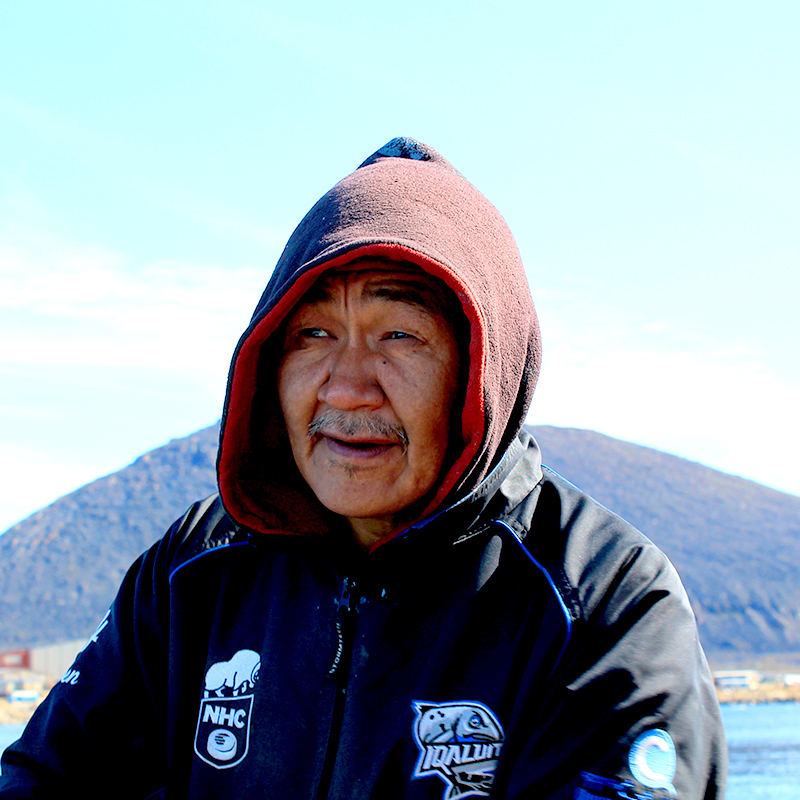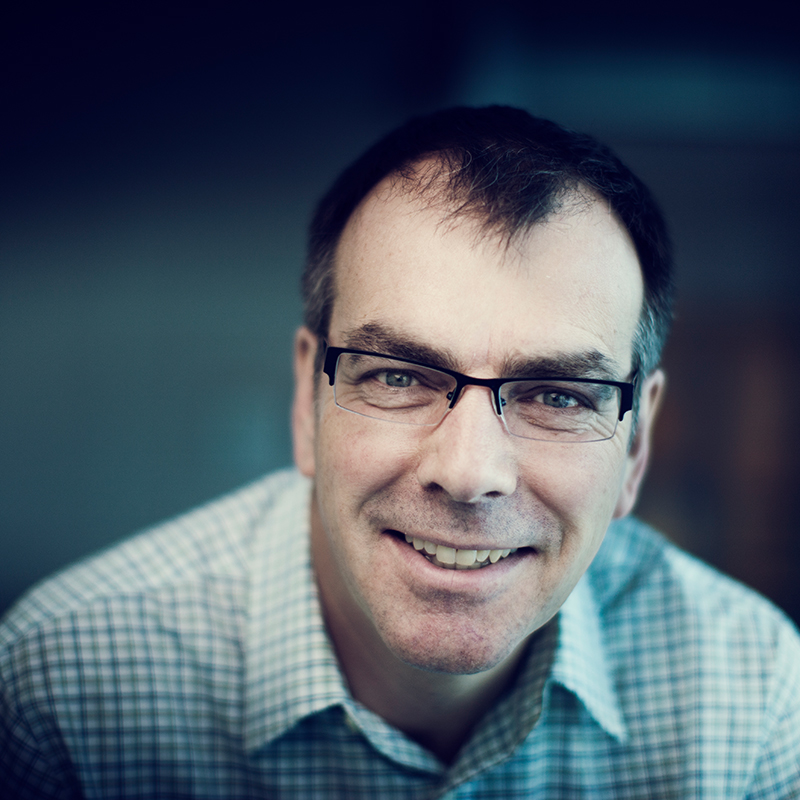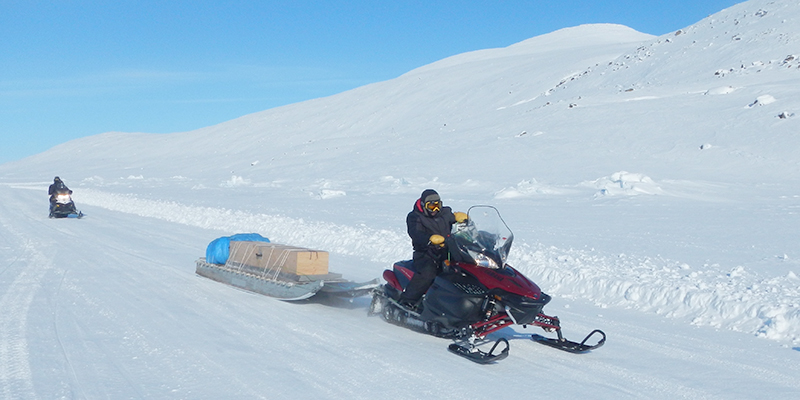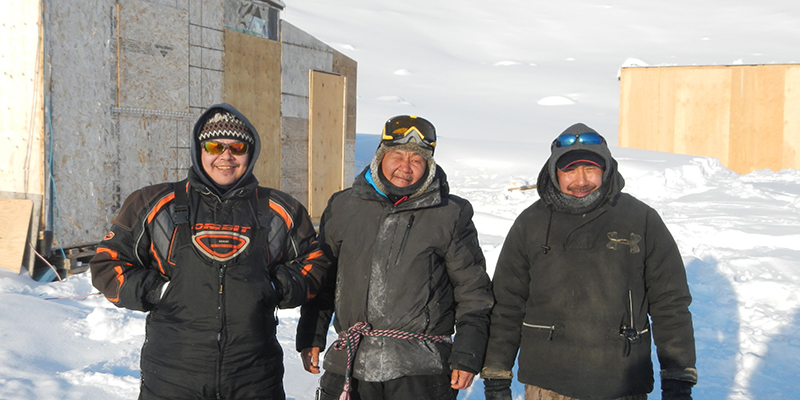SENSING
CHANGE
SENSING
CHANGE
SENSING
CHANGE
SENSING
CHANGE
SENSING
CHANGE

Jonah Keyookta

Dr. Trevor Bell

Carolann Harding
Carolann Harding
Building resiliency in the face of climate change
For Jonah Keyookta, sea ice is an extension of the land. The frozen ocean is a highway for hunting, fishing and travelling.
Mr. Keyookta lives in Qikiqtarjuaq, Nunavut, and depends on sea ice to travel and to access country foods.
“We travel through the ice all winter, starting when the sea freezes up, from December until July,” said Mr. Keyookta. “The ice is also used by local hunters.”
Increasingly, communities in Inuit Nunangat (Inuit homeland in Canada, from Nunatsiavut to Inuvialuit) are reporting that sea ice is thinning, forms later in the fall and breaks up earlier in the spring, making travel on the ice hazardous. The region where Mr. Keyookta lives is warming faster than any other part of the Arctic, according to the 2014 Integrated Regional Impact Study of Climate Change and Modernization in the Eastern Canadian Arctic, edited by Dr. Trevor Bell, University Research Professor in the Department of Geography, Faculty of Humanities and Social Sciences, and Dr. Tanya Brown, former post-doctoral fellow and Memorial alumna.
Mr. Keyookta has been working with Dr. Bell to implement new ice technology in Qikiqtarjuaq. SmartICE is a northern social enterprise focused on empowering communities through technology to adapt to unpredictable sea-ice changes resulting from climate change. SmartICE has developed the world’s first climate change adaption tool that integrates remote sensing, Inuit knowledge and ice technology to help people in the North travel more safely on the ice.
Building resiliency in the face of climate change
For Jonah Keyookta, sea ice is an extension of the land. The frozen ocean is a highway for hunting, fishing and travelling.
Mr. Keyookta lives in Qikiqtarjuaq, Nunavut, and depends on sea ice to travel and to access country foods.
“We travel through the ice all winter, starting when the sea freezes up, from December until July,” said Mr. Keyookta. “The ice is also used by local hunters.”
Increasingly, communities in Inuit Nunangat (Inuit homeland in Canada, from Nunatsiavut to Inuvialuit) are reporting that sea ice is thinning, forms later in the fall and breaks up earlier in the spring, making travel on the ice hazardous. The region where Mr. Keyookta lives is warming faster than any other part of the Arctic, according to the 2014 Integrated Regional Impact Study of Climate Change and Modernization in the Eastern Canadian Arctic, edited by Dr. Trevor Bell, University Research Professor in the Department of Geography, Faculty of Humanities and Social Sciences, and Dr. Tanya Brown, former post-doctoral fellow and Memorial alumna.
Mr. Keyookta has been working with Dr. Bell to implement new ice technology in Qikiqtarjuaq. SmartICE is a northern social enterprise focused on empowering communities through technology to adapt to unpredictable sea-ice changes resulting from climate change. SmartICE has developed the world’s first climate change adaption tool that integrates remote sensing, Inuit knowledge and ice technology to help people in the North travel more safely on the ice.
Building resiliency in the face of climate change
For Jonah Keyookta, sea ice is an extension of the land. The frozen ocean is a highway for hunting, fishing and travelling.
Mr. Keyookta lives in Qikiqtarjuaq, Nunavut, and depends on sea ice to travel and to access country foods.
“We travel through the ice all winter, starting when the sea freezes up, from December until July,” said Mr. Keyookta. “The ice is also used by local hunters.”
Increasingly, communities in Inuit Nunangat (Inuit homeland in Canada, from Nunatsiavut to Inuvialuit) are reporting that sea ice is thinning, forms later in the fall and breaks up earlier in the spring, making travel on the ice hazardous. The region where Mr. Keyookta lives is warming faster than any other part of the Arctic, according to the 2014 Integrated Regional Impact Study of Climate Change and Modernization in the Eastern Canadian Arctic, edited by Dr. Trevor Bell, University Research Professor in the Department of Geography, Faculty of Humanities and Social Sciences, and Dr. Tanya Brown, former post-doctoral fellow and Memorial alumna.
Mr. Keyookta has been working with Dr. Bell to implement new ice technology in Qikiqtarjuaq. SmartICE is a northern social enterprise focused on empowering communities through technology to adapt to unpredictable sea-ice changes resulting from climate change. SmartICE has developed the world’s first climate change adaption tool that integrates remote sensing, Inuit knowledge and ice technology to help people in the North travel more safely on the ice.

Jonah Keyookta surveying the ice road south of Qikiqtarjuaq with the SmartQAMUTIK
Jonah Keyookta surveying the ice road south of Qikiqtarjuaq with the SmartQAMUTIK
Social enterprise for new generations
Dr. Bell says the social enterprise approach to the project—drawing on expertise from the university and from the local community—helps empower the community.
“We’re putting into the hands of the community the tools they need to be able to adapt to these unpredictable, unprecedented conditions,” said Dr. Bell. “We’re training local people to use SmartICE because the communities are integral to help modify the technology and adapt it to their own sea ice environment. They know the ice, so they know how it will best work in their community.”
“Most importantly, sea-ice travel is part of Inuit culture and identity, and that’s what’s critical to understand. There’s a long history of Inuit use and knowledge of ice, and that’s why it’s so important for Inuit—especially for the Elders—that the information and skills of navigating on the ice are communicated and transferred to new generations. Technology alone is not a climate change solution.”
Addressing local needs
Carolann Harding, executive director of SmartICE, says community operators are central to the project’s success.
“Each community operator works closely with a community sea-ice user group (self-named Sikumiut) to understand where and when sea ice is most hazardous, how SmartICE can address local information needs, and in which ways Inuit knowledge can be incorporated with the technology,” said Ms. Harding.
Mr. Keyookta is a SmartICE community operator in Qikiqtarjuaq. He operates a mobile sensor on the ice, co-ordinates with the community on how SmartICE operates in the community and how the information is shared with sea-ice users.
“I really like it,” said Mr. Keyookta. “I’ve learned a lot from Trevor Bell. We use a snowmobile and SmartQAMUTIK. We put that on the back and drive on the ice. It’s helping a lot. People keep asking me how the trail is going north or south. It’s helping a lot for my community.”
Dr. Bell says there is a great deal of potential for Memorial to help build thriving and resilient communities by reimagining how to work with—and operate in—communities.
“It’s not just a place where research is done; it’s a place where relationships and trust are built over the long term, and where we create capacity for communities to be able to research their own priorities,” said Dr. Bell. “If that sounds like it could apply to any rural community in our province, I think it’s true. And I think SmartICE itself could act as a guide for respectfully working with other remote and rural communities in our province.”
Social enterprise for new generations
Dr. Bell says the social enterprise approach to the project—drawing on expertise from the university and from the local community—helps empower the community.
“We’re putting into the hands of the community the tools they need to be able to adapt to these unpredictable, unprecedented conditions,” said Dr. Bell. “We’re training local people to use SmartICE because the communities are integral to help modify the technology and adapt it to their own sea ice environment. They know the ice, so they know how it will best work in their community.”
“Most importantly, sea-ice travel is part of Inuit culture and identity, and that’s what’s critical to understand. There’s a long history of Inuit use and knowledge of ice, and that’s why it’s so important for Inuit—especially for the Elders—that the information and skills of navigating on the ice are communicated and transferred to new generations. Technology alone is not a climate change solution.”
Addressing local needs
Carolann Harding, executive director of SmartICE, says community operators are central to the project’s success.
“Each community operator works closely with a community sea-ice user group (self-named Sikumiut) to understand where and when sea ice is most hazardous, how SmartICE can address local information needs, and in which ways Inuit knowledge can be incorporated with the technology,” said Ms. Harding.
Mr. Keyookta is a SmartICE community operator in Qikiqtarjuaq. He operates a mobile sensor on the ice, co-ordinates with the community on how SmartICE operates in the community and how the information is shared with sea-ice users.
“I really like it,” said Mr. Keyookta. “I’ve learned a lot from Trevor Bell. We use a snowmobile and SmartQAMUTIK. We put that on the back and drive on the ice. It’s helping a lot. People keep asking me how the trail is going north or south. It’s helping a lot for my community.”
Dr. Bell says there is a great deal of potential for Memorial to help build thriving and resilient communities by reimagining how to work with—and operate in—communities.
“It’s not just a place where research is done; it’s a place where relationships and trust are built over the long term, and where we create capacity for communities to be able to research their own priorities,” said Dr. Bell. “If that sounds like it could apply to any rural community in our province, I think it’s true. And I think SmartICE itself could act as a guide for respectfully working with other remote and rural communities in our province.”
Social enterprise for new generations
Dr. Bell says the social enterprise approach to the project—drawing on expertise from the university and from the local community—helps empower the community.
“We’re putting into the hands of the community the tools they need to be able to adapt to these unpredictable, unprecedented conditions,” said Dr. Bell. “We’re training local people to use SmartICE because the communities are integral to help modify the technology and adapt it to their own sea ice environment. They know the ice, so they know how it will best work in their community.”
“Most importantly, sea-ice travel is part of Inuit culture and identity, and that’s what’s critical to understand. There’s a long history of Inuit use and knowledge of ice, and that’s why it’s so important for Inuit—especially for the Elders—that the information and skills of navigating on the ice are communicated and transferred to new generations. Technology alone is not a climate change solution.”
Addressing local needs
Carolann Harding, executive director of SmartICE, says community operators are central to the project’s success.
“Each community operator works closely with a community sea-ice user group (self-named Sikumiut) to understand where and when sea ice is most hazardous, how SmartICE can address local information needs, and in which ways Inuit knowledge can be incorporated with the technology,” said Ms. Harding.
Mr. Keyookta is a SmartICE community operator in Qikiqtarjuaq. He operates a mobile sensor on the ice, co-ordinates with the community on how SmartICE operates in the community and how the information is shared with sea-ice users.
“I really like it,” said Mr. Keyookta. “I’ve learned a lot from Trevor Bell. We use a snowmobile and SmartQAMUTIK. We put that on the back and drive on the ice. It’s helping a lot. People keep asking me how the trail is going north or south. It’s helping a lot for my community.”
Dr. Bell says there is a great deal of potential for Memorial to help build thriving and resilient communities by reimagining how to work with—and operate in—communities.
“It’s not just a place where research is done; it’s a place where relationships and trust are built over the long term, and where we create capacity for communities to be able to research their own priorities,” said Dr. Bell. “If that sounds like it could apply to any rural community in our province, I think it’s true. And I think SmartICE itself could act as a guide for respectfully working with other remote and rural communities in our province.”

From left are SmartICE operators Daniel Kooneeliusie, Jonah Keyookta and Jimmy Alikatuktuk
From left are SmartICE operators Daniel Kooneeliusie, Jonah Keyookta and Jimmy Alikatuktuk
From left are SmartICE operators Daniel Kooneeliusie, Jonah Keyookta and Jimmy Alikatuktuk
The SmartICE operators in Qikiqtarjuaq, from left: Daniel Kooneeliusie, Jonah Keyookta and Jimmy Alikatuktuk
Knowledge as a driver for well-being
In the next two years, SmartICE plans to establish operations in at least 15-20 communities across Inuit Nunangat, and is opening a technology production facility in Nain, Nunatsiavut.
“We are opening the first-ever technology production centre in the North for the North,” said Dr. Bell. “We will be training Inuit youth in Nain in the spring/summer of 2019 to assemble our technology for distribution to communities across Inuit Nunangat. We are asking the community about the skills and outcomes they would like to see from the production centre in their community so we can design our training programs to match those needs.
“SmartICE demonstrates another approach for how the university can empower and inspire youth in communities—whether they’re urban, rural, Indigenous or remote—to embrace knowledge, learning, technology and research as a driver of not just economic development, but also of well-being and resilience in their communities.”
Knowledge as a driver for well-being
In the next two years, SmartICE plans to establish operations in at least 15-20 communities across Inuit Nunangat, and is opening a technology production facility in Nain, Nunatsiavut.
“We are opening the first-ever technology production centre in the North for the North,” said Dr. Bell. “We are in the process of training Inuit youth in Nain to assemble our technology for distribution to communities across Inuit Nunangat. We are asking the community about the skills and outcomes they would like to see from the production centre in their community so we can design our training programs to match those needs.
“SmartICE demonstrates another approach for how the university can empower and inspire youth in communities—whether they’re urban, rural, Indigenous or remote—to embrace knowledge, learning, technology and research as a driver of not just economic development, but also of well-being and resilience in their communities.”
Knowledge as a driver for well-being
In the next two years, SmartICE plans to establish operations in at least 15-20 communities across Inuit Nunangat, and is opening a technology production facility in Nain, Nunatsiavut.
“We are opening the first-ever technology production centre in the North for the North,” said Dr. Bell. “We will be training Inuit youth in Nain in the spring/summer of 2019 to assemble our technology for distribution to communities across Inuit Nunangat. We are asking the community about the skills and outcomes they would like to see from the production centre in their community so we can design our training programs to match those needs.
“SmartICE demonstrates another approach for how the university can empower and inspire youth in communities—whether they’re urban, rural, Indigenous or remote—to embrace knowledge, learning, technology and research as a driver of not just economic development, but also of well-being and resilience in their communities.”
MEMORIAL UNIVERSITY | Newfoundland and Labrador's University | OFFICE of THE PRESIDENT | president@mun.ca | 709 864 8212
MEMORIAL UNIVERSITY OF NEWFOUNDLAND | Newfoundland and Labrador's University | OFFICE of THE PRESIDENT | president@mun.ca | 709 864 8212
MEMORIAL UNIVERSITY OF NEWFOUNDLAND | Newfoundland and Labrador's University | OFFICE of THE PRESIDENT | president@mun.ca | 709 864 8212
MEMORIAL UNIVERSITY OF NEWFOUNDLAND | Newfoundland and Labrador's University
| OFFICE of THE PRESIDENT | president@mun.ca | 709 864 8212
OFFICE of THE PRESIDENT | president@mun.ca | 709 864 8212 |
MEMORIAL UNIVERSITY of NEWFOUNDLAND
